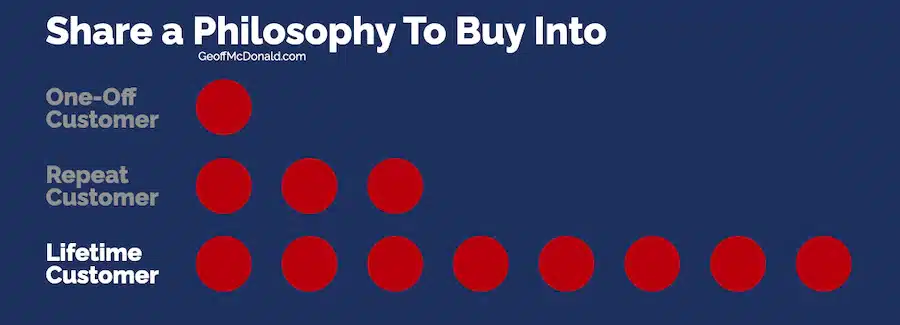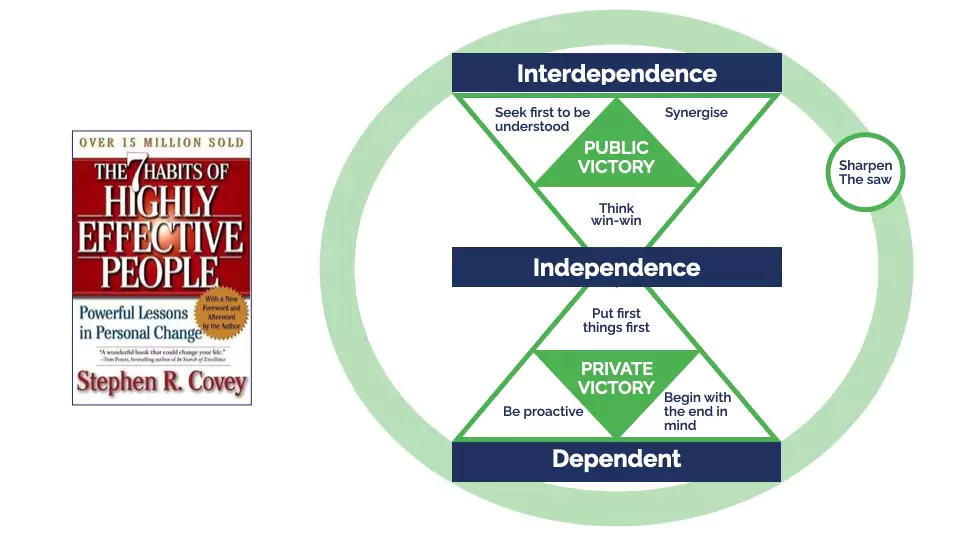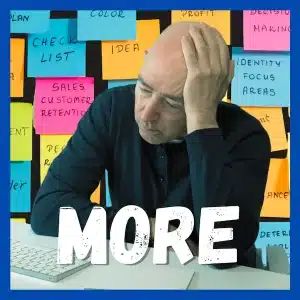This is the Expert Manifesto – it’s a manifesto example for thought leaders. It answers the question: If you were setting up your ideal business around your business expertise, what would it look like? What does your ultimate business look like? There are seven principles here to consider…
1 Own your own niche
The problem with not owning your niche is the level of competition you face.
One way to see your level of competition is to do some searches on Google and see how many responses show up. For instance:
- Leadership = 4.4 billion responses
- Leadership expert = 564 million responses
- Disruptive leadership = 71 million
- Disruptive leadership in healthcare = 9 million
That’s a lot of competition. Even something as specific as disruptive leadership in healthcare returns 9 million responses. Now that doesn’t mean there are nine million business consultants in direct competition with you offering this as a service but it does show there is a lot of talk about a seemingly niche topic.
One of the big mistakes I’ve made in my career is that I haven’t focused on a niche. And this has made it difficult to be known for what I do. I had always felt that if I niched down too small I would miss out on attracting new clients. The downside is by doing this I wasn’t known for any one thing and my clients didn’t know how to refer me – which cost more sales and income.
While having a niche is good, having your own niche is a lot better. That’s why I love calling myself the Ideas Architect. How many other Ideas Architects do you know?
What’s the best way to own a niche?
First, come up with your own term. Analogies like Ideas Architect work really well here.
Second, write a book with that title. A seminar or keynote might also work, but books still have a lot higher perceived value and credibility.
2 Attract your ideal clients
For anyone in business, you soon realise that some clients are better than others. Some never pay on time. Some constantly challenge your expertise. And some are just plain rude.
If you set the goal of having ideal clients you can build a business that serves only these people. This is likely to be more profitable and enjoyable.
There are two parts to consider here:
- You want to stop spending time chasing clients. You want them to come to you.
- And you want to work with the right people.
What’s the best way to attract your ideal clients?
First, you need to define who you want to attract. It helps to know what qualities an ideal client possesses so you can design ways to attract them.
Second, publish content. Traditional marketing suggests you identify your ideal clients and then go and hang out where they are. It’s the old fishing analogy – cast your line where the fish are biting. But this might not be enough given the qualities we often look for in clients can be more about personal values and personality styles. That’s why content marketing is a great way to attract your ideal clients. If you publish in an authentic way, only the people who like your approach will contact you. And that’s ideal!
3 Unite with a double-sided vision
Do you have a vision for your future?
You need one. You wouldn’t set out on a holiday without knowing your destination, would you? Having a clear vision of the future you want to create helps you make decisions in the present.
If you do have a clear vision, is it selfish?
Oops. Most mission and vision statements are selfish – they’re all about you. They don’t include the benefits you provide to your clients or to your community.
For example, a lot of vision statements are all about how you will make lots of money and grow into the most wonderful organisation.
That might be a great goal. But, it’s selfish. It’s all about you and what you want.
That’s fine if the goal was a personal one but when you’re building a business you can’t do this alone. You need other people. You’ll need suppliers, clients and probably a team. A selfish goal might work for you (the self) but it’s not going to be inspiring to others.
How to Transform a Selfish Goal
But the good news it’s usually easy to transform a selfish goal.
For example, to build a thriving organisation is all about you – it’s selfish. Simply add a reason why – add an ‘in order to’ statement at the end. For instance, ‘To build a thriving organisation to enable local communities to grow’. Now it’s not about you.
Better still, you could just run with the public goal: ‘to enable local communities to grow’. You can still have your internal goal of building a thriving organisation, but you can also engage others through your external goal of helping the community.
Now, that’s a generic example. But, hopefully, you get the point that if you include your client or community perspective in your vision you’ll engage yourself and other people more effectively. Best of all, you might even entice other people to join you on your mission.
Remember, a selfish goal excludes others, a selfless goal includes others. Ideally, you need both – you need to satisfy your needs as well as others.
4 Share a philosophy to buy into
Too many people focus on selling a product or service.
On the surface, that sounds like an outrageous thing to say. Of course, you want to sell your product or service – that’s how you’ll earn money, pay the bills and keep the lights on.
But the problem here is that might generate short-term sales only.
A few years back I was involved in a project where I was working with car salespeople from Mercedes Benz. The interesting thing I noticed, particularly from the older salespeople, was what they focused on – they didn’t try to sell people a car. Instead, they wanted to sell a lifetime of cars.
They had statistics that showed that a typical buyer would purchase a new car roughly every 5-7 years. The senior and more successful salespeople played the long game knowing that if they built a loyal following of car buyers they would have a stream of sales and income in the years to come. They might have to work hard for the first decade but after that, the customers would simply come back for more.
Importantly, this meant they didn’t try to sell the merits of the current car standing in the showroom. Instead, they focused on what Mercedes Benz stood for as a car company – luxury, performance, quality, and safety. The customers weren’t buying cars, they were buying a philosophy.
The Key to Lifetime Customers
If you want to build lifetime loyalty filled with repeat customers you need to share a philosophy they can buy into.
For example, The Expert Manifesto is part of my philosophy. These are the principles that I’m working toward. And if you were to work with me, you would be buying into these principles too.
This is the key to building a strong brand and a loyal following of advocates who come back again and again. Attract lifetime customers not one-off sales.
5 Build an idea that scales
What makes someone an expert? Experts know something that is valuable. It might be what to do or how to do it.
That becomes a business when the expert can share their expertise in ways that other people are willing to pay for. And they become successful when they can serve enough people at the right price.
This means if your idea doesn’t scale then you severely limit your chances of building a profitable business – especially a global business.
The scale of your idea is related to three things:
- Relevancy – who wants and needs your idea?
- Impact – what level of value does it provide?
- Availability – how many people you can easily share it with?
The best way to build an idea that scales is to create a framework. This parallels our previous point about having a philosophy to buy into.
A great example of an idea that scales based on a framework is Stephen Covey’s Seven Habits of Highly Effective People. He wrote books about it and he partnered with Franklin (now known as Franklin Covey) to create a worldwide training business.
The key is he created principles or habits that could be applied to almost any situation which makes it easy to scale.
6 Play a game worth winning
What game are you playing in your business?
Now, you might not think of your business as a game – it’s a serious endeavour, isn’t it? Of course, it is. That’s what makes this point so important.
Let’s ask the same question in a different way: What’s the context for your business? Or in popular terms, what’s your purpose?
You must play a game that you want to win otherwise, why would you bother even starting?
And this is crucial for those tough times when it feels like running your business is an uphill job – which for many of us can be most days.
A game worth winning is up to you and there are two ways to create this.
- You might align it to your double-sided vision (point 3) or you might create it as a specific internal business result. What’s the community benefit of your business?
- Another perspective on this is to ask, what is the legacy you’re leaving behind when you’re done? When you’ve grabbed your gold watch and headed off to the beach, golf course or to play with your grandkids, and you look back at your life’s work, what impact will you have made?
What game are you playing?
7 Write the rules for success
We all have rules that run our lives every day.
In large organisations, you’ll see more formal rules like We work from 9-5. Lunch is one hour. These might even be written into your employment contract. When you’re trying to coordinate action between a lot of people you need these rules.
But when you work for yourself or with a small team, you’re more likely to have more informal or unwritten rules. ‘I start work when I do.’ Or, ‘I finish when the job is done or I’ve had enough – whichever comes first.’
Unwritten rules also form the culture of an organisation – ‘that’s how we do things around here’.
In contrast, when you work for yourself or in a small team, you might have more of these unwritten rules. For instance, ‘it doesn’t matter what time you start or finish each day, just get the necessary work done.’
As a business expert, you have another set of rules – for your clients. For instance, when I work with a client I always start with defining their manifesto. This is the foundation piece of work that I believe must be done before other things can be created.
I may be the only person on the planet who has that rule. But it works for me. And it works for my clients (because they tell me it does).
When you write the rules for success then you become the expert in the game. It’s your business and it’s your expertise. And it follows that you have your own rules for success. Not mine. Not the guy down the street or the woman on the speaking platform next to you.
Two Types of Rules for Success
There are two big types of rules for success that you need.
- The first are the rules you use when accepting and working with clients. For instance, you might only work with women. Or you might only start work when a 20% deposit is paid.
- And the second set of rules is how you work. For instance, I don’t work on client projects on the weekend or after 6pm. No email replies, no phone calls. Nothing.
What are your rules for success? Spend time thinking about them. And write them down.
Summary: The Expert Manifesto
The point of this post is two-fold.
- First, it’s to share a set of ideals that you may pursue in your business as a subject matter expert or thought leader. I encourage you to write down your ideals for your business. What does your ideal business look and feel like?
- Second, this is an example of a thought leadership manifesto. It is part of my philosophy and my body of work that I share to inspire and attract my ideal clients. I encourage you to write down the rules or guidelines you use to work with your clients as a way to stand out and brand yourself.
More Manifesto Examples for Thought Leaders
If you’d like more manifesto examples for thought leadership, you might like to read these posts next:
- Thought Leadership Content – What is a Manifesto?
- The best types of thought leadership content to create
- Content Creation Canvas: Build Thought Leadership Attract New Clients
Plus there are more than 250 manifesto examples over at 1000manifestos.com








